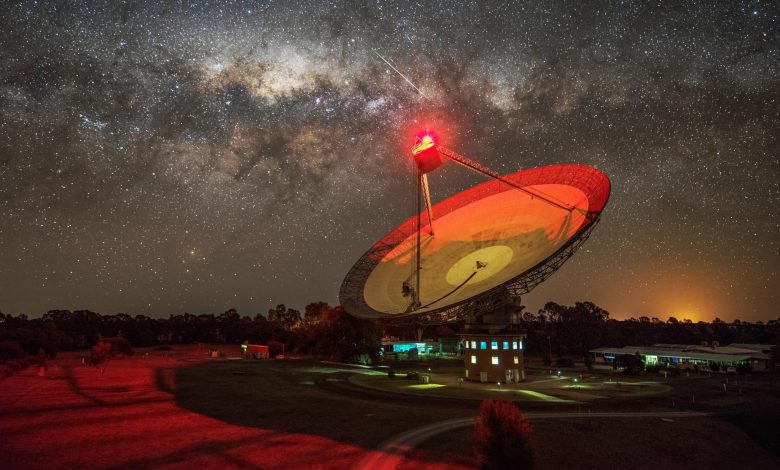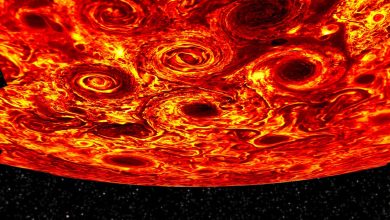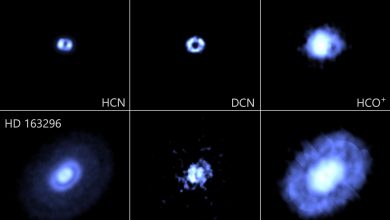
The Parkes radio telescope in Australia. Credit: CSIRO
An intriguing candidate signal picked up last year by the Breakthrough Listen project has been subjected to intensive analysis that suggests it is unlikely to originate from the Proxima Centauri system. Instead, it appears to be an artifact of Earth-based interference from human technologies, the Breakthrough Initiatives announced today. Two research papers, published in Nature Astronomy, discuss both the detection of the candidate signal and an advanced data analysis process that can finely discern “false positives.”
“The significance of this result is that the search for civilizations beyond our planet is now a mature, rigorous field of experimental science,” said Yuri Milner, founder of Breakthrough Inititatives.
Breakthrough Listen (a program of the Breakthrough Initiatives) is an astronomical science program searching for technosignatures – signs of technology that may have been developed by extraterrestrial intelligence. Listen’s science team, led by Dr. Andrew Siemion at the University of California, Berkeley, uses some of the largest radio telescopes in the world, equipped with the most capable digital processing systems, to capture data across broad swaths of the radio spectrum in the direction of a wide range of celestial targets. The search is challenging because Earth is awash with radio signals from human technology – cell phones, radar, satellites, TV transmitters, and so on. Searching for a faint signal from a distant star is akin to picking out a needle in a vast digital haystack – and one that is changing constantly over time.
The CSIRO Parkes Telescope in New South Wales, Australia (one of the largest telescopes in the Southern Hemisphere, known as ‘Murriyang’ in Wiradjuri) is among the facilities participating in Breakthrough Listen’s search. One of the targets being monitored by Parkes is Proxima Centauri, the Sun’s nearest neighboring star, at a distance of just over 4 light years. The star is a red dwarf orbited by two known exoplanets. The Listen team scanned the target across a frequency range of 700 MHz to 4 GHz, with a resolution of 3.81 Hz – in other words, performing the equivalent of tuning to over 800 million radio channels at a time, with exquisite detection sensitivity.
Shane Smith, an undergraduate researcher working with Listen Project Scientist Dr. Danny Price in the summer 2020 Breakthrough Listen internship program, ran the data from these observations through Breakthrough Listen’s search pipeline. He detected over 4 million “hits” – frequency ranges that had signs of radio emission. This is actually quite typical for Listen’s observations; the vast majority of these hits make up the haystack of emissions from human technology.
As with all of Listen’s observations, the pipeline filters out signals which look like they are unlikely to be coming from a transmitter at a large distance from Earth, according to two main criteria:
- Firstly, is the signal steadily changing in frequency with time? A transmitter on a distant planet would be expected to be in motion with respect to the telescope, leading to a Doppler drift akin to the change in pitch of an ambulance siren as it moves relative to an observer. Rejecting hits with no such signs of motion reduces the number of hits from 4 million to around 1 million for this particular dataset.
- Secondly, for the hits that remain, do they appear to be coming from the direction of the target? To determine this, the telescope points in the direction of Proxima Centauri, and then points away, repeating this “ON – OFF” pattern several times. Local interfering sources are expected to affect both ON and OFF observations, whereas a candidate technosignature should appear only in the ON observations.
Even after both of these data filters are applied, a handful of candidates remain that must be inspected visually. Sometimes a faint signal is actually visible in the OFF observations but is not quite strong enough to be picked up by automated algorithms. Sometimes similar signals appear in neighboring observations, indicative of interfering sources that may be turning on and off at just the wrong period, or the team can track down the signals to satellites that commonly broadcast in certain frequency bands.
Occasionally an intriguing signal remains and must be subjected to further checks. Such a signal-of-interest was discovered by Smith in Listen’s observations of Proxima Centauri using the Parkes telescope. A narrow-band, Doppler-drifting signal, persisting over five hours of observations, that appears to be present only in “ON” observations of the target star and not in the interspersed “OFF” observations, had some of the characteristics expected from a technosignature candidate.
Dr. Sofia Sheikh, currently a postdoctoral researcher with the Listen team at UC Berkeley, dug into a larger dataset of observations taken at other times. She found around 60 signals that share many characteristics of the candidate, but are also seen in their respective OFF observations.
“We can therefore confidently say that these other signals are local to the telescope and human-generated,” says Sheikh. “The signals are spaced at regular frequency intervals in the data, and these intervals appear to correspond to multiples of frequencies used by oscillators that are commonly used in various electronic devices. Taken together, this evidence suggests that the signal is interference from human technology, although we were unable to identify its specific source. The original signal found by Shane Smith is not obviously detected when the telescope is pointed away from Proxima Centauri – but given a haystack of millions of signals, the most likely explanation is still that it is a transmission from human technology that happens to be ‘weird’ in just the right way to fool our filters.”
Executive Director of the Breakthrough Initiatives Dr. S. Pete Worden remarked, “While we were unable to conclude a genuine technosignature, we are increasingly confident that we have the necessary tools to detect and validate such signatures if they exist.”
Breakthrough Listen is making all of the data from the Parkes scans available to the public to examine for themselves. The team has also just published two papers (led by Smith and Sheikh) outlining the details of the data acquisition and analysis, and a research note describing follow-up observations of Proxima Centauri conducted with the Parkes Telescope in April 2021. Listen will continue monitoring of Proxima Centauri, which remains a compelling target for technosignature searches, using a suite of telescopes around the world. And the team continues to refine algorithms to improve their ability to discriminate between “needles” and “hay”, including as part of a recently-completed crowdsourced data processing competition in collaboration with kaggle.com.
“In the case of this particular candidate,” remarks Siemion, “our analysis suggests that it’s highly unlikely that it is really from a transmitter out at Proxima Centauri. However, this is undoubtedly one of the most intriguing signals we’ve seen to date.”
References:
“Analysis of the Breakthrough Listen signal of interest blc1 with a technosignature verification framework” by Sofia Z. Sheikh, Shane Smith, Danny C. Price, David DeBoer, Brian C. Lacki, Daniel J. Czech, Steve Croft, Vishal Gajjar, Howard Isaacson, Matt Lebofsky, David H. E. MacMahon, Cherry Ng, Karen I. Perez, Andrew P. V. Siemion, Claire Isabel Webb, Andrew Zic, Jamie Drew and S. Pete Worden, 25 October 2021, Nature Astronomy.
DOI: 10.1038/s41550-021-01508-8
“A radio technosignature search towards Proxima Centauri resulting in a signal of interest” by Shane Smith, Danny C. Price, Sofia Z. Sheikh, Daniel J. Czech, Steve Croft, David DeBoer, Vishal Gajjar, Howard Isaacson, Brian C. Lacki, Matt Lebofsky, David H. E. MacMahon, Cherry Ng, Karen I. Perez, Andrew P. V. Siemion, Claire Isabel Webb, Jamie Drew, S. Pete Worden and Andrew Zic, 25 October 2021, Nature Astronomy.
DOI: 10.1038/s41550-021-01479-w





